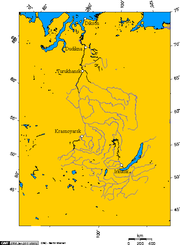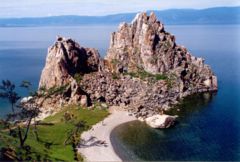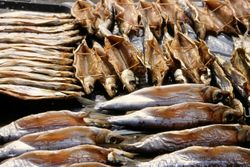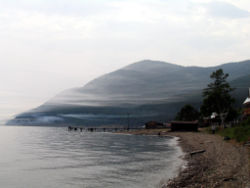Lake Baikal
2007 Schools Wikipedia Selection. Related subjects: General Geography
| Lake Baikal, Russia | |
|---|---|
|
|
|
| Coordinates | |
| Lake type | Continental rift lake |
| Primary sources | Selenga Chikoy Khiloh Uda Barguzin Upper Angara |
| Primary outflows | Angara River |
| Catchment area | 560,000 square kilometers (347,968 mi²) |
| Basin countries | Russia |
| Max-length | 636 kilometers (395 mi) |
| Max-width | 80 kilometers (50 mi) |
| Surface area | 31,494 square kilometers (12,159 mi²) |
| Average depth | 758 meters (2,487 ft) |
| Max-depth | 1637 meters (5369 ft) |
| Water volume | 23,600 cubic kilometers (5,521 mi³) |
| Shore length1 | 2,100 kilometers (1,305 mi) |
| Surface elevation | 456 meters (1,496 ft) |
| Islands | 22 |
| Settlements | Irkutsk |
| 1 Shore length is an imprecise measure which may not be standardized for this article. | |
Lake Baikal lies in Southern Siberia in Russia between Irkutsk Oblast to the northwest and Buryatia to the southeast near the city of Irkutsk. In Russian, it is called Байка́л (Ozero Baykal, О́зеро literally meaning Lake, pronounced ['ozʲɪrə bʌj'kɑl]), and in the Buryat and Mongol languages it is called Dalai-Nor, or "Sacred Sea". The origin of the name Baikal comes from Baigal or Байгал which is translated from the Mongolian language as "nature". It is also known as the Blue Eye of Siberia.
Lake Baikal is the deepest and oldest lake in the world as well as the largest (by volume) freshwater lake. It contains over 20% of the world's liquid fresh surface water and more than 90% of Russia's liquid fresh surface water. It is a World Heritage Site. Olkhon, by far the largest island in Lake Baikal, is the second largest lake-bound island in the world (the largest being Manitoulin Island in Lake Huron).
Geography and hydrography
Very little was known about Lake Baikal until the Trans-Siberian railway was built between 1896 and 1902. The scenic loop encircling Lake Baikal required 200 bridges and 33 tunnels. At the same time the railway was being built, a large hydrogeographical expedition headed by F.K. Drizhenko produced the first detailed atlas of the contours of Baikal's depths.
The atlas demonstrated that Lake Baikal has as much water as all of North America's Great Lakes combined — 23,600 km³, about 20% of the total fresh water on the earth. However, in surface area, it is exceeded by the much shallower Great Lakes Superior, Huron and Michigan, as well as by the relatively shallow Lake Victoria in East Africa. Known as the "Galápagos of Russia", its age and isolation have produced one of the world's richest and most unusual freshwater faunas, which is of exceptional value to evolutionary science.
At 636 kilometres long and 80 km wide, Lake Baikal has the largest surface area of any freshwater lake in Asia ( 31,494 km²) and is the deepest lake in the world (1637 metres, previously measured at 1620 metres). The bottom of the lake is 1285 metres below sea level, but below this lies some 7 km (4 miles) of sediment, placing the rift floor some 8–9 km (more than 5 miles) down: the deepest continental rift on Earth. In geological terms, the rift is young and active — it widens about 2 centimeters per year. The fault zone is also seismically active: there are hot springs in the area and notable earthquakes every few years.

Its age is estimated at 25–30 million years, making it one of the most ancient lakes in geological history. It is unique among large, high-latitude lakes in that its sediments have not been scoured by overriding continental ice sheets. US and Russian studies of core sediment in the 1990s provide a detailed record of climatic variation over the past 250,000 years. Longer and deeper sediment cores are expected in the near future. If all the sediment were scoured from the lake, the lake would be a further 7km below sea surface (the water from above would replace the scoured sediment so the depth of the lake itself would not change).
The lake is completely surrounded by mountains. the Baikal Mountains on the north shore and taiga, is technically protected as a national park and contains 22 small islands, the largest, Olkhon (also spelled 'Olchon'), being 72km long. The lake is fed by some 300 inflowing rivers, the six main ones being Selenga, the source of some of Baikal's pollution, Chikoy, Khiloh, Uda, Barguzin and Upper Angara, and is drained through a single outlet, the Angara River.
Despite its great depth, the lake's waters are well-mixed and well-oxygenated throughout the water column, compared to the stratification of bodies such as Lake Tanganyika and the Black Sea.
Despite muted protests, a wood pulp and cellulose processing plant was built at the south end of the lake (at Baikalsk). The plant still pours industrial effluent into Baikal's waters. The overall impacts of watershed pollution on Baikal and similar watersheds is studied annually by the Tahoe-Baikal Institute, an exchange program between U.S., Russian, and Mongolian scientists and university graduate students started in 1990.
Wildlife
The extent of biodiversity present in Lake Baikal is equalled by few other lakes. Lake Baikal hosts 1085 species of plants and 1550 species and varieties of animals. Over 60% of animals are endemic; e.g., 27 of 52 species of fish are endemic. The Baikal Seal (Phoca sibirica), the only mammal living in the lake, is found throughout the whole area of the lake but nowhere else.
Of note is an endemic subspecies of the omul fish (Coregonus autumnalis migratorius). It is fished, smoked, and sold on all markets around the lake. For many travellers on the Trans-Siberian railway, purchasing smoked omul is one of the highlights on the long journey.
Bear and deer are observable and hunted along Baikal coasts.
Ecology
Baikalsk Pulp and Paper Mill
Baikalsk Pulp and Paper Mill (BPPM) was constructed in 1966 directly on the shore line. The BPPM bleaches its paper with chlorine and discharges the waste into Baikal. Despite numerous protests, the BPPM is still in production. Environmental activists are now in a struggle to make the pollution less harmful rather than end BPPM's production since a plant shutdown would be problematic due to local socioeconomic issues.
Planned East Siberia-Pacific Ocean pipeline
Russian state company Transneft was planning to build a trunk pipeline that would have come within 800m (0.5mi) of the lake shore in a zone of substantial seismic activity. Environmental activists in Russia, Greenpeace Baikal pineline opposition and local citizens were strongly opposed to these plans due to the possibility of an accidental oil spill that might cause significant damage to the environment. Numerous meetings were held recently in Russian cities, especially in Irkutsk. However, Russian president Vladimir Putin ordered the company to consider an alternative route to the north, to avoid such ecological risks. Transneft has since decided to move the pipeline away from Lake Baikal so that it will not pass through any federal or republic natural reserves.
Lake Baikal is also home to 12 hundred species of animals and the world's only freshwater seal.


